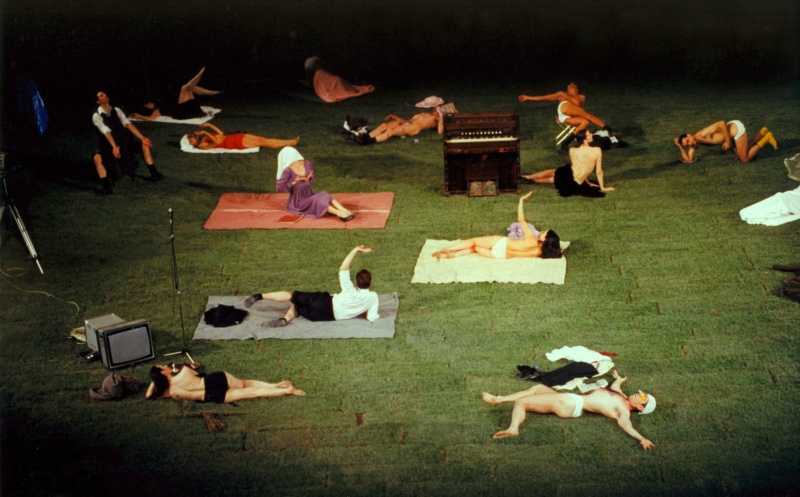 1980 is one of the seminal productions of the late 20th Century, and in retrospect a production that once seen makes the nature of contemporary performance become a little clearer. Not only does it clarify the myriad ways in which Piña Bausch carved a distinctive figure in theatre and dance, but also hints at many of the subsequent features of prominent British theatre-makers. The boldness of the mise en scène, here in 1980 a carpet of grass and a fake deer; the playful arrangement of fragments of human interaction, here a collage of games and competitions; and the sharp social observations of the lives we lead.
1980 is one of the seminal productions of the late 20th Century, and in retrospect a production that once seen makes the nature of contemporary performance become a little clearer. Not only does it clarify the myriad ways in which Piña Bausch carved a distinctive figure in theatre and dance, but also hints at many of the subsequent features of prominent British theatre-makers. The boldness of the mise en scène, here in 1980 a carpet of grass and a fake deer; the playful arrangement of fragments of human interaction, here a collage of games and competitions; and the sharp social observations of the lives we lead.
In the last decade, since the staging of Kontakthof with people over the age of 65, Bausch has also led the way in using dancers of various ages. This has become more and more important since her death as, in spite of the loyalty Bausch engendered in her performers, fewer dancers who worked on the original pieces still dance with the company. In this re-staging of 1980, a wide mix of dancers from the original work and more recent company members create a breadth of ages that adds another layer to its meditation on the games we used to play as children, and still play as adults.
1980, despite its length of over three and a half hours, and complex layering, is simple in premise. Nineteen dancers, assisted by a magician and gymnast, play games, compete with one another and parade for the audience. What makes this work so captivating and remarkable is the careful balance that Bausch achieves in the juxtaposition of the carefree jouissance of the games and competitions with the sombre restraint of fragments of social dance. It is this collision of these two tones that creates the pathos of 1980. The naive, joyful and sometimes wilful attitude of the game play is reminiscent of a freedom we are rarely allowed to experience as adults, a kind of paean to the frustrations of maturity. Equally, the images of deadpan dancing couples hint at the anaesthetised existence that faces us if we deny our capacity for childlike exuberance.
One of the most delicious parts of 1980 as an experience is the shift of rhythms throughout the work and the way these rhythms play against the images Bausch and her dancers shape. The – now iconic – sunbathing scene, for example, in which the dancers twist and shift their bodies into increasingly contorted positions to catch the rays of the sun on different body parts, sets the humour and ridiculousness of the positions against the rhythms of a lazy sunny day. This is emblematic of Bausch at her finest, re-framing everyday activities with careful precision to elevate apparent mundane simplicity into striking examples of human frailty, shaped with careful artifice but without descending into the artificial.
